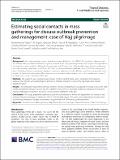| dc.contributor.author | Tofighi, Mohammadali | |
| dc.contributor.author | Asgary, Ali | |
| dc.contributor.author | Tofighi, Ghassem | |
| dc.contributor.author | Najafabadi, Mahdi M. | |
| dc.contributor.author | Arino, Julien | |
| dc.contributor.author | Amiche, Amine | |
| dc.contributor.author | Rahman, Ashrafur | |
| dc.contributor.author | McCarthy, Zachary | |
| dc.contributor.author | Bragazzi, Nicola L. | |
| dc.contributor.author | Thommes, Edward | |
| dc.contributor.author | Coudeville, Laurent | |
| dc.contributor.author | Grunnill, Martin D. | |
| dc.contributor.author | Bourouiba, Lydia | |
| dc.date.accessioned | 2022-09-06T13:48:08Z | |
| dc.date.available | 2022-09-06T13:48:08Z | |
| dc.date.issued | 2022-09-01 | |
| dc.identifier.uri | https://hdl.handle.net/1721.1/145261 | |
| dc.description.abstract | Abstract
Background
Most mass gathering events have been suspended due to the SARS-CoV-2 pandemic. However, with vaccination rollout, whether and how to organize some of these mass gathering events arises as part of the pandemic recovery discussions, and this calls for decision support tools. The Hajj, one of the world's largest religious gatherings, was substantively scaled down in 2020 and 2021 and it is still unclear how it will take place in 2022 and subsequent years. Simulating disease transmission dynamics during the Hajj season under different conditions can provide some insights for better decision-making. Most disease risk assessment models require data on the number and nature of possible close contacts between individuals.
Methods
We sought to use integrated agent-based modeling and discrete events simulation techniques to capture risky contacts among the pilgrims and assess different scenarios in one of the Hajj major sites, namely Masjid-Al-Haram.
Results
The simulation results showed that a plethora of risky contacts may occur during the rituals. Also, as the total number of pilgrims increases at each site, the number of risky contacts increases, and physical distancing measures may be challenging to maintain beyond a certain number of pilgrims in the site.
Conclusions
This study presented a simulation tool that can be relevant for the risk assessment of a variety of (respiratory) infectious diseases, in addition to COVID-19 in the Hajj season. This tool can be expanded to include other contributing elements of disease transmission to quantify the risk of the mass gathering events. | en_US |
| dc.publisher | BioMed Central | en_US |
| dc.relation.isversionof | https://doi.org/10.1186/s40794-022-00177-3 | en_US |
| dc.rights | Creative Commons Attribution | en_US |
| dc.rights.uri | https://creativecommons.org/licenses/by/4.0/ | en_US |
| dc.source | BioMed Central | en_US |
| dc.title | Estimating social contacts in mass gatherings for disease outbreak prevention and management: case of Hajj pilgrimage | en_US |
| dc.type | Article | en_US |
| dc.identifier.citation | Tropical Diseases, Travel Medicine and Vaccines. 2022 Sep 01;8(1):19 | en_US |
| dc.contributor.department | Massachusetts Institute of Technology. Department of Civil and Environmental Engineering | |
| dc.identifier.mitlicense | PUBLISHER_CC | |
| dc.eprint.version | Final published version | en_US |
| dc.type.uri | http://purl.org/eprint/type/JournalArticle | en_US |
| eprint.status | http://purl.org/eprint/status/PeerReviewed | en_US |
| dc.date.updated | 2022-09-04T03:13:52Z | |
| dc.language.rfc3066 | en | |
| dc.rights.holder | The Author(s) | |
| dspace.date.submission | 2022-09-04T03:13:51Z | |
| mit.license | PUBLISHER_CC | |
| mit.metadata.status | Authority Work and Publication Information Needed | en_US |
